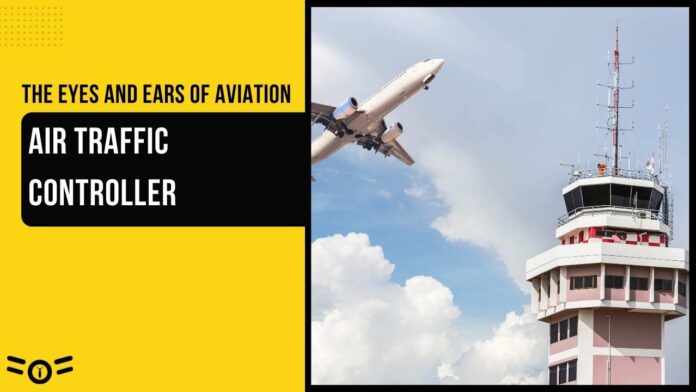
AIR TRAFFIC CONTROLLERS:
Air traffic control (ATC) is a service provided by ground-based controllers who direct aircraft on the ground and in the air.
The primary purpose of ATC systems worldwide is:
- To separate aircraft to prevent collisions
- To organize and speed up the flow of traffic
- To provide information and other support for pilots when able.
Air traffic controllers are the people who operate the air traffic control systems to speed up and maintain a safe and orderly flow of air traffic and help prevent mid-air collisions.
THE TOWER: In the entire airport, the tallest building is the air traffic control tower. Airport Traffic Control Towers provide for a safe, orderly, and expeditious flow of traffic in the vicinity of an airport. When the responsibility is delegated, towers also provide for the separation of Instrument Flight Rules aircraft in the terminal areas.
OBJECTIVES OF THE AIR TRAFFIC SERVICES:
The objectives of the air traffic services shall be to:
- Prevent collisions between aircraft.
- Prevent collisions between aircraft in the maneuvering area and obstructions in that area.
- Speed up and maintain an orderly flow of air traffic.
- Provide advice and information useful for the safe and efficient conduct of flights.
Notify appropriate organizations regarding aircraft in need of search and rescue aid, and assist such organizations as required.
DIVISIONS OF THE AIR TRAFFIC SERVICES:
The air traffic services comprise three services identified as follows:
- Air traffic control service
Area Control Service:
The provision of air traffic control service for controlled flights, except for those parts of such flights which are under the jurisdiction of Approach Control or Aerodrome Control, to accomplish the following objectives:
- Prevent collisions between aircraft
- Speed up and maintain an orderly flow of air traffic
Approach control service:
The provision of air traffic control service for those parts of controlled flights associated with arrival or departure.
Aerodrome control service:
The provision of air traffic control service for aerodrome traffic, except for those parts of flights that are under the jurisdiction of Approach Control.
- Flight information service:
- Provide advice and information useful for the safe and efficient conduct of flights.
- Alerting service:
Notify appropriate organizations regarding aircraft in need of search and rescue aid and assist such organizations as required.
Federal Aviation Administration (FAA) – CAREER IN AIR TRAFFIC CONTROL
Air Traffic Control Specialists: “The following information is provided by the Federal Aviation Administration (FAA).”

Every minute, every hour, and every day, there are men and women working to ensure the safety and efficiency of our national airspace system.
This elite group of more than 14,000 FAA air traffic control specialists provides a vital public service to guide pilots, their planes and 2.7 million daily passengers from taxi to takeoff, through the air, and back safely on the ground.
PAY, BENEFITS, HOURS:
The approximate median annual wage for air traffic control specialists is $127,805. The salaries for entry-level air traffic control specialists increase as they complete each new training phase.
The annual salary for more advanced controllers who have completed on-the-job training varies with the location of the facility, the complexity of the airspace, and other factors.
As federal employees, air traffic control specialists receive a benefits package that rivals, if not surpasses, those offered in the private sector, with a variety of insurance, retirement, leave and flexible spending options for employees and their families.
Most air traffic control specialists work full time, and some work additional hours. Larger air traffic control facilities operate continuously, and employees may rotate among the day, evening, and night shifts, along with weekends and holidays. Smaller facilities have more standard dawn to dusk operating hours.
Because of the serious nature of this work and zero margins for error, the training regimen and proficiencies needed to become an air traffic control specialist are demanding. Initial selection does not guarantee placement into federal civilian service. Entry-level applicants must complete required training courses at the FAA Academy in Oklahoma City and gain on-the-job experience before becoming certified professional controllers.
MINIMUM REQUIREMENTS:
According to the FAA regulations and policies, the minimum requirements for joining the air traffic control are as follows:
- 1. Be age 30 or under (on the closing date of the application period)
- 2. Pass a medical examination
- 3. Pass a security investigation
- 4. Pass the FAA air traffic pre-employment test
- 5. Speak English clearly enough to be understood over communications equipment
- 6. Have three years of progressively responsible work experience, or a Bachelor’s degree, or a combination of post-secondary education and work experience that totals three years
- 7. Be willing to relocate to an FAA facility based on agency staffing needs
The FAA offers employment opportunities for individuals with previous air traffic control experience, as well as entry-level trainee air traffic control specialists, through separate job vacancy announcements posted for a limited time throughout the year.
“Note: Certain conditions might differ from country to country, so according to the FAA regulations, the respective country must clear all the conditions provided by the FAA.”
TRAINING FOR AIR TRAFFIC CONTROLLER:
There are serval institutions across the world that provide such training, but one of the most efficient institutions is located in the United States of America in Nebraska.
AIR TRAFFIC CONTROL SCHOOL IN NEBRASKA: Air Traffic Controller Schools in Nebraska are actively recruiting students to replace the thousands of current controllers from Nebraska whose retirement is rapidly approaching. Aviation Schools Online offers a complete list of air traffic controller schools near Nebraska. They provide career planning and other related information regarding Air Traffic Control.
Thank you for reading, for more follow Aeronefs.



